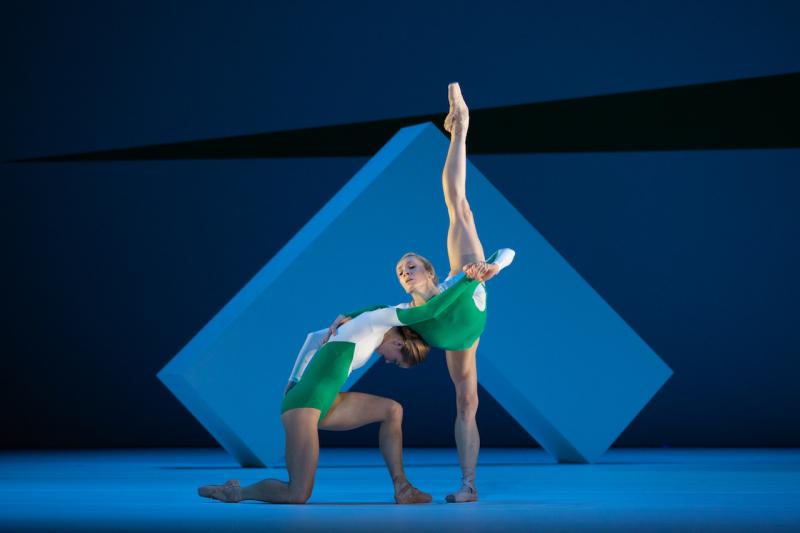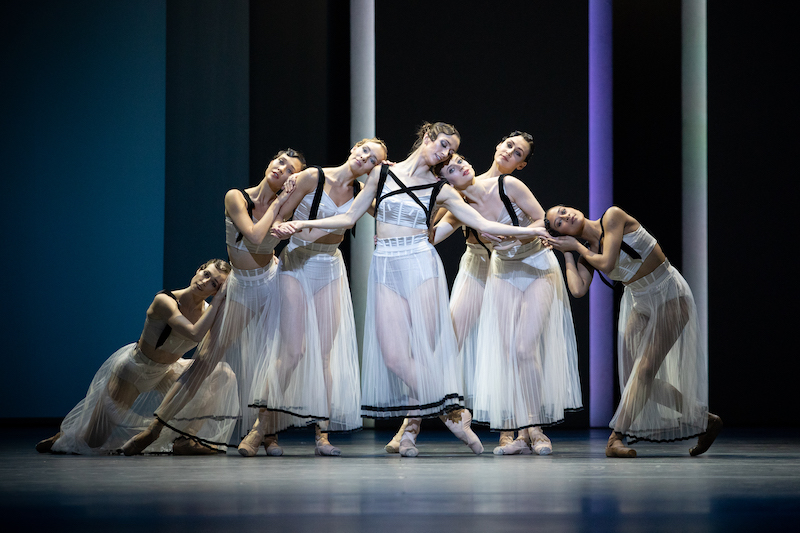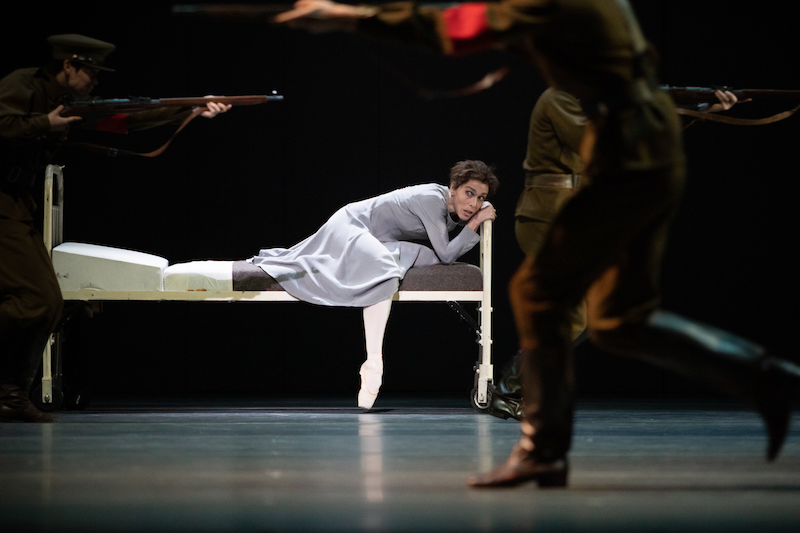Untitled, 2023 / Corybantic Games / Anastasia Act III, Royal Ballet review - a magnificent end to the season | reviews, news & interviews
Untitled, 2023 / Corybantic Games / Anastasia Act III, Royal Ballet review - a magnificent end to the season
Untitled, 2023 / Corybantic Games / Anastasia Act III, Royal Ballet review - a magnificent end to the season
There's grist and glory in this triple bill, and a career-high for Wayne McGregor

Is it a cop-out for an artist to label a piece of work “Untitled”? Painters and sculptors make a habit of it, reasoning that they want to leave the viewer free to bring to the experience what they will, unhampered and unlimited by prior information. Odd, then, that dance, being such an ambiguous, free-associating art form, should be so far behind the curve.
Wayne McGregor’s latest work for the Royal Ballet is the first “Untitled” that I have come across in three decades of watching dance. It is also one of the most exciting new non-narrative ballets in years.
Untitled, 2023 is named after the piece of visual art that forms its backdrop, a work by the late abstract-minimalist Cuban-American Carmen Herrera who died last year aged 106 and was approached to provide this, her first work for the stage, at 102. In bald terms, Herrera’s contribution is a backcloth painted with a wide green triangle on a startling white ground, and a white sculptural shape, waist-height, on the floor. Neither refers to anything specific. Were we to be told that the triangle (pictured below) was a mountain, or an arrowhead, or a graph, we’d pursue that line of thought. Left to our own devices, the green triangle nags at the brain to be something else, or multiple other things, possibly all at once. McGregor’s choice of music chimes with this visual austerity in a way that guides those thoughts – or perhaps it's the art that guides the music. The orchestral works of Icelandic composer Anna Thorvaldsdottir use epic forces to present great granite blocks of sound within which individual pitches, barely discernable, become pockets of rhythm that seethe and bubble and slither like molten lava. As with Herrera’s triangle, it offers us nothing familiar to clutch at, yet I found I wasn’t alone in finding within this massive sound thoughts of ocean deeps, tectonic plates and the bulk and density of icebergs.
McGregor’s choice of music chimes with this visual austerity in a way that guides those thoughts – or perhaps it's the art that guides the music. The orchestral works of Icelandic composer Anna Thorvaldsdottir use epic forces to present great granite blocks of sound within which individual pitches, barely discernable, become pockets of rhythm that seethe and bubble and slither like molten lava. As with Herrera’s triangle, it offers us nothing familiar to clutch at, yet I found I wasn’t alone in finding within this massive sound thoughts of ocean deeps, tectonic plates and the bulk and density of icebergs.
The introduction of 19 dancers into this vast sensual environment is bracing. Dressed (by Daniel Lee of Burberry) in unitards in different graphic permutations of green and white, it’s as if the bodies are ice shards that have briefly detached from Herrera’s painting. Everything connects. Too often in new ballets made for the Opera House main stage, detail gets lost in the vastness, perhaps because choreographers panic about filling the space and over-fill it, distracting the eye. McGregor, now a veteran of three decades of dance-making, boldly gives us less, and in this richly suggestive visual and aural context less is indeed more.
And while there is plenty of the hyper-extended, hyper-articulated body language McGregor is famous for, there are also moments of felicitous lightness, as when two girls break away in sync with each other, hopping and fluttering like finches oblivious of a volcano that could be about to blow. McGregor has learnt much from the experiments of the late Merce Cunningham, especially about creating complex micro-rhythms of steps within huge swathes of sound not made for dancing. Gesamtkünstwerk is an unwieldy word for a work as cleanly limned as this, but the unity and cogency, not to mention beauty, of McGregor’s Untitled, 2023, is phenomenal. The programme is completed by two other pieces generated from within the Royal Ballet. Christopher Wheeldon’s Corybantic Games, new in 2018, glances back to the sporting contests of Ancient Greece. The music is Leonard Bernstein’s Serenade (after Plato’s Symposium) which adds another historical stratum with its brash, bright, Hollywood Bowl era confidence. The stage is busy, but Wheeldon’s genius for organising space guides the eye. There are gorgeous moments (pictured above) when the pace suddenly calms and the women lean into one another, heads drooped, as if posing for a sculpture. Elsewhere, Mayara Magri makes a superb athlete-in-chief, moving her long strong limbs at fizzing speed.
The programme is completed by two other pieces generated from within the Royal Ballet. Christopher Wheeldon’s Corybantic Games, new in 2018, glances back to the sporting contests of Ancient Greece. The music is Leonard Bernstein’s Serenade (after Plato’s Symposium) which adds another historical stratum with its brash, bright, Hollywood Bowl era confidence. The stage is busy, but Wheeldon’s genius for organising space guides the eye. There are gorgeous moments (pictured above) when the pace suddenly calms and the women lean into one another, heads drooped, as if posing for a sculpture. Elsewhere, Mayara Magri makes a superb athlete-in-chief, moving her long strong limbs at fizzing speed.
Kenneth MacMillan’s one-act ballet Anastasia comes with some curious baggage. It’s a taut little drama that tells the story, with clever economy, of a woman in a Berlin mental asylum who believed she was the Grand Duchess Anastasia Romanov – having survived the assassination of the rest of her family in 1917. At the time of its premiere in 1967, half the world (including the choreographer) believed, or hoped, that she really was. A DNA test in 1994, three years after MacMillan’s death, proved decisively that she wasn’t. Yet this makes barely a dent in the ballet’s power. It now works as an emotive study of early-onset dementia and loss of identity. Against an aural backdrop of electronic burblings and music by Martinu, the woman, flanked by her nurses and psychiatrists, watches scraps of flickery home movies from the Romanov archive. Well-heeled visitors come to gawp at her. She suffers flashbacks, some benign, some terrifying, but all of them a feasible reaction to the stories that are fed to her. Laura Morera (pictured above), in her final role before retirement, is riveting to watch, whether sprinting dementedly around the perimeter of the stage, or wrestling with nightmare visions of her nemesis, the creepy Rasputin, or rifle-wielding Bolsheviks. It’s a priceless role for a dancer of Morera’s dramatic gifts, and MacMillan’s experimental expressionism (a style he rarely visited again) gives them thrillingly free rein.
Against an aural backdrop of electronic burblings and music by Martinu, the woman, flanked by her nurses and psychiatrists, watches scraps of flickery home movies from the Romanov archive. Well-heeled visitors come to gawp at her. She suffers flashbacks, some benign, some terrifying, but all of them a feasible reaction to the stories that are fed to her. Laura Morera (pictured above), in her final role before retirement, is riveting to watch, whether sprinting dementedly around the perimeter of the stage, or wrestling with nightmare visions of her nemesis, the creepy Rasputin, or rifle-wielding Bolsheviks. It’s a priceless role for a dancer of Morera’s dramatic gifts, and MacMillan’s experimental expressionism (a style he rarely visited again) gives them thrillingly free rein.
rating
Share this article
The future of Arts Journalism
You can stop theartsdesk.com closing!
We urgently need financing to survive. Our fundraising drive has thus far raised £49,000 but we need to reach £100,000 or we will be forced to close. Please contribute here: https://gofund.me/c3f6033d
And if you can forward this information to anyone who might assist, we’d be grateful.

Subscribe to theartsdesk.com
Thank you for continuing to read our work on theartsdesk.com. For unlimited access to every article in its entirety, including our archive of more than 15,000 pieces, we're asking for £5 per month or £40 per year. We feel it's a very good deal, and hope you do too.
To take a subscription now simply click here.
And if you're looking for that extra gift for a friend or family member, why not treat them to a theartsdesk.com gift subscription?
more Dance
 'We are bowled over!' Thank you for your messages of love and support
Much-appreciated words of commendation from readers and the cultural community
'We are bowled over!' Thank you for your messages of love and support
Much-appreciated words of commendation from readers and the cultural community
 R:Evolution, English National Ballet, Sadler's Wells review - a vibrant survey of ballet in four acts
ENB set the bar high with this mixed bill, but they meet its challenges thrillingly
R:Evolution, English National Ballet, Sadler's Wells review - a vibrant survey of ballet in four acts
ENB set the bar high with this mixed bill, but they meet its challenges thrillingly
 Like Water for Chocolate, Royal Ballet review - splendid dancing and sets, but there's too much plot
Christopher Wheeldon's version looks great but is too muddling to connect with fully
Like Water for Chocolate, Royal Ballet review - splendid dancing and sets, but there's too much plot
Christopher Wheeldon's version looks great but is too muddling to connect with fully
 iD-Reloaded, Cirque Éloize, Marlowe Theatre, Canterbury review - attitude, energy and invention
A riotous blend of urban dance music, hip hop and contemporary circus
iD-Reloaded, Cirque Éloize, Marlowe Theatre, Canterbury review - attitude, energy and invention
A riotous blend of urban dance music, hip hop and contemporary circus
 How to be a Dancer in 72,000 Easy Lessons, Teaċ Daṁsa review - a riveting account of a life in dance
Michael Keegan-Dolan's unique hybrid of physical theatre and comic monologue
How to be a Dancer in 72,000 Easy Lessons, Teaċ Daṁsa review - a riveting account of a life in dance
Michael Keegan-Dolan's unique hybrid of physical theatre and comic monologue
 A Single Man, Linbury Theatre review - an anatomy of melancholy, with breaks in the clouds
Ed Watson and Jonathan Goddard are extraordinary in Jonathan Watkins' dance theatre adaptation of Isherwood's novel
A Single Man, Linbury Theatre review - an anatomy of melancholy, with breaks in the clouds
Ed Watson and Jonathan Goddard are extraordinary in Jonathan Watkins' dance theatre adaptation of Isherwood's novel
 Peaky Blinders: The Redemption of Thomas Shelby, Rambert, Sadler's Wells review - exciting dancing, if you can see it
Six TV series reduced to 100 minutes' dance time doesn't quite compute
Peaky Blinders: The Redemption of Thomas Shelby, Rambert, Sadler's Wells review - exciting dancing, if you can see it
Six TV series reduced to 100 minutes' dance time doesn't quite compute
 Giselle, National Ballet of Japan review - return of a classic, refreshed and impeccably danced
First visit by Miyako Yoshida's company leaves you wanting more
Giselle, National Ballet of Japan review - return of a classic, refreshed and impeccably danced
First visit by Miyako Yoshida's company leaves you wanting more
 Quadrophenia, Sadler's Wells review - missed opportunity to give new stage life to a Who classic
The brilliant cast need a tighter score and a stronger narrative
Quadrophenia, Sadler's Wells review - missed opportunity to give new stage life to a Who classic
The brilliant cast need a tighter score and a stronger narrative
 The Midnight Bell, Sadler's Wells review - a first reprise for one of Matthew Bourne's most compelling shows to date
The after-hours lives of the sad and lonely are drawn with compassion, originality and skill
The Midnight Bell, Sadler's Wells review - a first reprise for one of Matthew Bourne's most compelling shows to date
The after-hours lives of the sad and lonely are drawn with compassion, originality and skill
 Ballet to Broadway: Wheeldon Works, Royal Ballet review - the impressive range and reach of Christopher Wheeldon's craft
The title says it: as dancemaker, as creative magnet, the man clearly works his socks off
Ballet to Broadway: Wheeldon Works, Royal Ballet review - the impressive range and reach of Christopher Wheeldon's craft
The title says it: as dancemaker, as creative magnet, the man clearly works his socks off
 The Forsythe Programme, English National Ballet review - brains, beauty and bravura
Once again the veteran choreographer and maverick William Forsythe raises ENB's game
The Forsythe Programme, English National Ballet review - brains, beauty and bravura
Once again the veteran choreographer and maverick William Forsythe raises ENB's game

Add comment